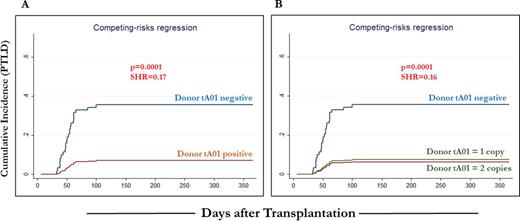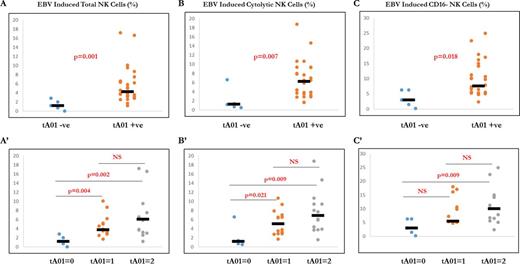Abstract
BACKGROUND: Recipientsof allogeneic HCT remain vulnerable to a heightened risk of reactivation of otherwise latent viral infections owing to a compromised immune system early after transplantation. Uncontrolled reactivation of Epstein-Barr virus (EBV) leading to post-transplant lymphoproliferative disorder (PTLD) is one of such major complications after T-cell depleted HCT. Recovering within weeks after transplantation and being first in line of defense against viral infections, natural killer (NK) cells are deemed important in the immunopathogenesis of EBV complications. Their role however remains elusive. NK cell responses are regulated by a series of activating and inhibitory cell surface receptors, central to which are the Killer Immunoglobulin-like Receptors (KIR). Through these receptors NK cells discriminate healthy cells from 'altered' self-cells by scaling the perturbations in HLA expression after viral transformation of the target cell. Here, we set out to determine whether and how KIR gene and motifs' content of HCT donors and/or recipients influences the development of PTLD after allo-HCT.
STUDY DESIGN:
Hypothesizing that diverse NK cell receptor repertoires can titrate NK cell functional responses to EBV infections/reactivation and can potentially modify the risk of developing PTLD, we determined the KIR gene repertoires of 356 HLA-matched donor-recipient pairs of first allo-HCT and 50 healthy donors through Next Generation Sequencing of the KIR locus on the Illumina MiSeq platform. Based on the presence/absence and number of copies of individual genes, the KIR genotypes were determined and classified into four common centromeric (cA01, cB01, cB02 and cB03) and two telomeric (tA01 and tB01) motifs along with their variants. PBMNCs from KIR typed healthy volunteers were stimulated with EBV-transformed target cells to enumerate NK cell response to EBV (degranulation and/or IFNγ production) as a function of KIR gene content and motifs' distribution using a multicolor flow cytometry-based assay. Effect of KIR gene profile on development of PTLD was analyzed using binomial competing risks regression statistics. Distribution of NK cell functional response across various KIR characterized groups was analyzed using Mann-Whitney U statistics.
RESULTS:
Donor telomeric A motifs (tA01, KIR3DL1+ve KIR2DS4+ve; KIR3DS1/2DS1+/-ve), strongly protected against PTLD (p=0.0001, SHR=0.17; Figure 1). An increased protection against PTLD with increasing number of tA01 was noted with at least one copy required for a significant protective effect (Figure 1B). Copy number analysis of tA01 gene contents yielded similar associations. Further, the number of EBV induced functional NK cell subsets were significantly higher in individuals with than without KIR genotypes containing tA01 motifs (Figure 2 A-C) and was found to be increasing with an increasing number of tA01 copies (Figure 2 A'-C'). There was no influence of recipients' KIR repertoire on the risk of developing PTLD
CONCLUSIONS:
NK cell responsiveness, a function of KIR gene repertoire has a profound effect on the development of PTLD. Appropriately characterized KIR gene profile based identification of HCT recipients at high risk of developing PTLD will enable closer monitoring of EBV DNAemia and facilitate prompt therapy.
Donor KIR telomeric A motif (tA01) protects against the risk of developing PTLD (A). Presence of at least one copy of donor KIR tA01 motif confers significant protection from PTLD (B)
Donor KIR telomeric A motif (tA01) protects against the risk of developing PTLD (A). Presence of at least one copy of donor KIR tA01 motif confers significant protection from PTLD (B)
KIR telomeric A motifs (tA01) titrate NK cells' functional response to Epstein-Barr virus infected cells (A-C), with and increasing %functional NK cells and subsets (measures as expressing CD107a, IFN-γ, or both) are observed with increasing tA01 motifs' copies (A'-C')
KIR telomeric A motifs (tA01) titrate NK cells' functional response to Epstein-Barr virus infected cells (A-C), with and increasing %functional NK cells and subsets (measures as expressing CD107a, IFN-γ, or both) are observed with increasing tA01 motifs' copies (A'-C')
No relevant conflicts of interest to declare.
Author notes
Asterisk with author names denotes non-ASH members.



